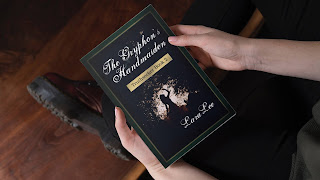So today's the release day for C.O. Bonham's new novel, Runaway Lyrics! Before we take a look at the book itself, here's a guest post from Bonham.
How the Dwarf kept his beard: Adapting a Fairytale to a Novel.
By C.O. Bonham
So the story of Snow White and Rose Red is odd. Here’s the TL;DR:
Snow White and her sister Rose Red live in a house in the forest with their mother. They are very sweet, get along well, and are kind to all the forest creatures.
One Winter night, a bear shows up at their house, and they welcome it in and become friends. He stays until summer, then leaves. The girls miss him, so they head out into the woods to find their gentle bear friend.
The girls meet a dwarf whose beard is snagged in a tree/bush/bramble (It varies). Snow cuts his beard free, even though he tells her not to. (I thought she was kind?)
They meet him again, and his beard is tangled in a fishing line. She cuts the beard again. When she could have just cut the line. (She doesn’t care about other people’s wishes much.)
Then he is carried by an Eagle. They throw rocks at it and it drops him. (Don’t they know they could have killed him?)
Anyway, the dwarf is angry and wants to attack them. (Can you blame him?) But the bear saves them and scares/kills (it varies) the dwarf. It’s okay because the dwarf is the villain for not being grateful. The bear turns into a prince and marries Snow White, and he has a brother who marries Rose Red.
Long story short: Snow White is sweet and kind, but she doesn’t respect the dwarf enough to not cut his beard.
So I thought, how can I make her kinder? And it turned into a weird message. She isn’t super sweet or nice to the dwarf. He is wasting their time and it would be so easy to just cut his beard. But she respects his wishes and finds another solution.
The story kind of snowballed from there. There’s a difference between being kind and being polite. Some of the worst serial killers in history had pleasant manners and friendly personalities.
Some of the rudest people can be very kind. Once, I was on the side of the road. Car after car passed me by. Finally, one stopped. The guy got out, asked what was wrong and then fixed the car for me. (The problem was embarrassingly simple, so no, I won’t tell you what it was.) He didn’t introduce himself, didn’t make small talk, just fixed it, waved off my offer of payment, and left.
He was very kind to stop and fix my car, even if others wouldn’t have called him friendly. In fact, a super friendly man might have set off a ton of red flags that would have made me hesitant to accept his help.
So the moral of the story: Kindness is not equal to politeness.
I looked at all the girls’ encounters with the dwarf and came up with new solutions, and I made Snow a little put out to emphasize my point. Then the hard part came. How to make a novel out of this.
I made the Bear prince kind of gender-swapped Snow White with the evil stepmother thing. I wanted a dragon, and I knew I needed to give the younger prince a bigger role. Then I wrote until all these random elements made sense together.
The younger brother got a name and a personality and then his part in the plot just exploded from there.
The girls’ each got a motivation, and it turns out that their mother had an excellent reason for living out in the middle of nowhere.
The main prince is still turned into a bear for no good reason. There is never a good reason for turning people into bears.
I added Steampunk because every story is better with steampunk.
So ends the tale of a problematic fairytale turned steampunk adventure novel.
Now go forth and be kind. Even if you can’t be polite while doing it.
***
Runaway Lyrics
What one sister has, she must share with the other . . .Snow loves music. She has spent her entire life learning, new instruments and memorizing new pieces, only to while away her life in a country manor with only her mother and twin sister as company. If only she could get out on her own and play in front of a real audience.
Rose loves magic. The things she can do with music would amaze her twin sister, but whenever she shows her, Snow quickly forgets as if the event had never happened. If only Rose could get out on her own and work some real magic.
When an airship crashes near their home Snow’s magical abilities awaken. Together the sisters must learn to use their magic, rescue a pair of cursed princes, and discover their own secrets.
Discover the magic of music in this retelling of Snow White and Rose Red.
***
Author Bio:
C.O. Bonham is the pen name for a commonly misspelled first name. She loves stories of all kinds, but really likes the ones that are weird, and outside the norm. A certified book geek, when she isn’t writing stories of her own, she is busy reading stories by others. A homeschool graduate with a degree in creative writing, her goal is to create stories that make people think, feel, and have fun.Visit www.cobonham.com to read author interviews, book reviews, and to hear about what she’s working on next.
Sign up for her newsletter to make sure you never miss an update!

































